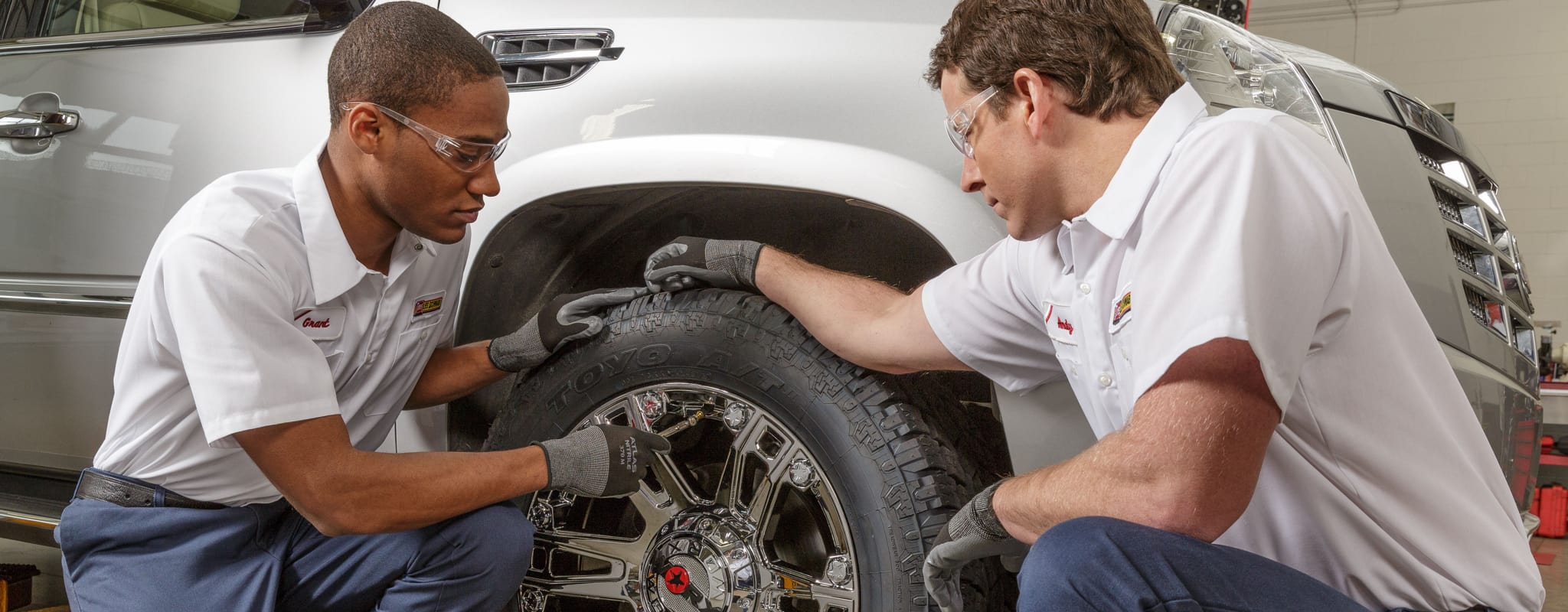Drive with Confidence: GMC Tires Service at Morris Tires
Drive with Confidence: GMC Tires Service at Morris Tires
Blog Article
Tire Solution: The Impact of Weather
When it comes to making sure optimum efficiency and security on the road, comprehending the effect of weather problems on tire service is crucial. GMC Tire Service. In this conversation, we will certainly check out the intricate relationship in between climate conditions and tire solution, dropping light on the significance of weather-specific tire maintenance methods and factors to consider.
Warm and Tire Performance
When revealed to heats, tires experience changes in efficiency that can substantially impact car safety and security and handling. The warm created from prolonged driving or heat problems creates the tire rubber to soften, resulting in reduced walk life and raised wear. As the rubber becomes softer, the tire's hold when driving diminishes, affecting stopping ranges and overall grip. In extreme instances, excessive warmth can also trigger tire blowouts, posturing a severe security risk to the lorry and its residents.

Winter Impacts
Cold climate problems can have a considerable effect on tire performance and security. As temperatures decline, tire rubber can harden, causing reduced grip on icy or snow-covered roadways. In winter, tires might additionally shed air stress more swiftly, which can affect managing and fuel performance. Furthermore, cool temperatures can cause tire sidewalls to stiffen, enhancing the risk of damages from holes or other road hazards.
To reduce the results of chilly climate on tires, it is crucial to routinely check tire stress and inflate them to the maker's suggested levels. Using winter season or all-season tires developed for cool weather problems can also improve traction and hold on icy or snowy roadways. Appropriate tire maintenance, consisting of normal inspections for wear and damages, ends up being a lot more critical throughout cooler months to make sure ideal efficiency and safety.
Rainy Issues Influence
Throughout rainy problems, tire performance and security can be substantially affected by the damp roadway surfaces and reduced visibility. The walk pattern of tires plays an essential role in keeping traction on damp roadways. Tires with damaged footsteps are more prone to hydroplaning, where a layer of water develops in between the tire and the roadway surface area, leading to loss of grip. To fight this, vehicle drivers should frequently inspect their tires for adequate tread deepness and consider purchasing tires specifically designed for wet problems.
Additionally, stormy weather can additionally decrease exposure, making it challenging for drivers to see the road in visit site advance clearly (GMC Tire Service). In such conditions, it is vital to change driving rates accordingly and preserve a safe following distance to permit for sudden quits. Effectively filled with air tires can likewise help in preserving control on wet my blog roadways by offering far better handling and hold
Snow and Tire Safety
When driving in snowy problems, having the best tires can make a significant difference in safety and performance. Winter months tires are designed with unique rubber substances and walk patterns to provide far better traction on snow and ice contrasted to all-season tires.

Additionally, motorists need to take into consideration installing tire chains in extreme snowy conditions. Tire chains supply additional grip by gripping the snow and ice, boosting stability and control. Nevertheless, it is very important to comply with producer guidelines when using and setting up tire chains to prevent damage to the tires and lorry. By choosing the best tires, maintaining proper inflation, and considering additional traction aids like tire chains, vehicle drivers can boost their safety when navigating snow-covered roadways.
Weather-Related Tire Upkeep
When encountered with different climate condition, appropriate tire upkeep comes to be an important aspect of automobile safety and security and performance. Weather-related tire maintenance incorporates a variety of techniques More Help aimed at ensuring ideal tire function and long life in different climate scenarios. One vital facet of weather-related tire upkeep is tire stress guideline. Fluctuating temperatures can create tire pressure to differ, impacting traction and gas efficiency. Consistently readjusting and checking tire stress according to supplier recommendations is crucial for risk-free driving in changing weather condition problems. In addition, tire walk deepness plays a significant duty in dealing with various climate aspects. Tires with appropriate step deepness provide much better grasp on damp or icy roadways, reducing the danger of hydroplaning or skidding. When walk wear gets to a certain deepness is important for preserving grip and security in negative weather, examining tire step regularly and changing tires. By prioritizing weather-related tire upkeep, chauffeurs can enhance safety, boost vehicle performance, and extend the life-span of their tires.
Conclusion
In verdict, weather problems have a substantial influence on tire efficiency and safety. From warmth affecting tire stress and use to cold weather condition decreasing traction, it is crucial to consider the weather when maintaining and using tires.
In this conversation, we will certainly discover the complex relationship in between weather conditions and tire service, dropping light on the relevance of weather-specific tire maintenance practices and considerations.

Report this page